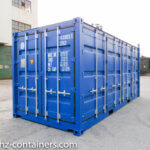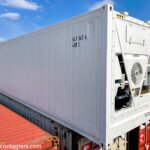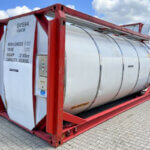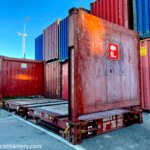Types of shipping containers
20′, 40′ or 40’HC are specific types of shipping containers. What do these mean, and how do you distinguish between the different types of shipping containers? First, we will discuss their basic classification, and then focus on specific dimensions and sizes of shipping containers.
The most common and most widely used shipping container is the so-called.
Dry Storage Container (Dry storage container)
There are several different sizes of storage containers. They mainly differ in height, width, length, and opening options.
Dry (dry) storage containers are the most common containers used in the transportation industry. They are available in lengths of 20, 40, and 45 feet and are intended for transporting or storing dry goods.
These containers do not allow for temperature regulation, so they are not suitable for transporting food or chemicals that require refrigeration.
There are approximately seventeen million containers in the world, and a large portion of the global long-distance cargo transportation in international trade is carried out in shipping containers.
The invention of these containers significantly contributed to the globalization of trade in the second half of the 20th century, as it drastically reduced shipping costs, thus facilitating long-distance trade.
This type of container is most commonly handled by cranes or trucks with hydraulic arms.
This basic and most widely used storage shipping container can also be divided into the following “subtypes”:
Storage Container HC – Higher
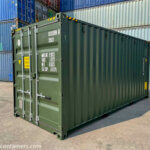
This is a classic storage container that is manufactured in a higher height than a standard container and is known as high cube – a container referred to as HC.
It is mainly used where there is a need to stack more goods vertically, for example.
It also exists in a version called “double-door”, meaning it can open from both shorter sides of the container.
If a shipping container is being converted into a garage or a residence (where higher clear height is required), the High Cube – HC sizes are also chosen.
Storage Container PW – Width for Euro Pallets
This Pallet Wide container, abbreviated PW, is manufactured with a larger width, allowing two euro pallets to fit side by side in the interior dimensions from the narrower side of the container.
They are most commonly sold in lengths of 20’HC and 40’HC, but can also be found in other specific sizes.
The width of the container is 2.462m compared to the standard external width of the container, which is 2.438m. It is especially suitable where goods are transported exclusively on euro pallets.
Storage container with side opening
It typically always features an opening from the shorter front side + side opening from one side
Storage container with side openings has one long side that can be fully opened. The option to open is also available from both the left and right longer sides, which is called a double side door container.
This is particularly advantageous for wide goods that are difficult to fit through the standard opening from the front narrow side of the storage container.
The side opens as if it were two large doors, but it can still be secured to protect the goods or materials inside.
Shipping container with open top
Called an open top container, this also has various types of top openings – a covering tarp, which is also known from truck transportation.
A shipping container with an open top is essentially a type of dry container, but without the top part. This allows for easy loading of goods through the top of the container using a crane, or bulk cargo.
The roof of the container consists of a removable aluminum frame onto which a roof covering tarp is attached, which can be secured with ropes to provide protection against rain and other weather conditions. The container’s contents are loaded and unloaded through the top using a portal crane.
In this category, there is also the so-called hard top – which is a container with a solid roof that can be opened from the top.
Construction cell – office
A shipping container used as a construction cabin or office is a specially modified shipping container designed to serve as a portable, temporary, or mobile workplace.
This type of container is commonly used on construction sites, in the construction industry, on temporary projects, in the military, or as mobile offices.
They are typically insulated and equipped with electrical facilities, such as lighting, outlets, connections for electronics, and heating or air conditioning to provide a suitable work environment.
Garage from a shipping container
Another example of a specially modified container is a garage from a shipping container. This type of container is designed and adapted for use as a parking space, storage for tools, workspace, or workshop.
Compared to a traditional garage, it has several advantages. It is easily movable and secure, as it is made of strong steel, which protects the vehicle from unauthorized access and external damage.
Containers can be easily customized to your needs. For example, you can have two garage doors, one entry door, and one garage door, etc., depending on the customer’s requirements.
Residential Shipping Containers
Residential shipping containers can be made from standard storage shipping containers ranging from 20′ to 40′ in size or from High Cube containers, which are taller. Residential shipping containers can be created.
They can be used for short-term and long-term functional housing.
Depending on the requirements, they can be equipped with insulation, electrical and plumbing connections, air conditioning, and heating, ensuring comfortable living in various climatic conditions.
They are also easily transportable, so when you change your plans, you can simply transport the shipping container elsewhere using trucks, ships, or cranes.
Special Purpose Containers
The following types of shipping containers are special containers, known in English as special purpose containers, which are very specific, and they include types of containers such as these:
Refrigerated and Freezer ISO Containers
Refrigerated container or freezer container is used in freight transport, is insulated, and is primarily used for transporting temperature-sensitive cargo. Refrigerated and freezer containers are capable of regulating temperatures from -65 °C to 40 °C.
It has a built-in cooling unit, but it relies on external power from electrical power sources (so-called “reefer points”) on land, on a container ship, or at a dock.
When transported by road on a trailer or in a railway car, they can be powered by diesel generators (“generator sets”), which connect to the shipping container while driving on the road.
Tank Containers
Tanks are storage containers used to store liquids. They are special types of containers designed for transporting and storing liquid or gaseous substances. They are typically made from corrosion-resistant materials due to the chemicals transported in them.
Tank containers are widely used for international transport of hazardous chemicals such as acids, solvents, oils, fuels, pesticides, etc. They are designed to minimize the risk of leakage and pollution. They are often used for transporting liquids such as diesel, gasoline, etc.
Tank containers are also frequently used for transporting liquefied gases such as liquid propane, butane, or ethylene. They are designed to handle high-pressure and low-pressure gases and are equipped with special safety features to minimize the risk of explosion.
Half height containers – half height containers
Half height containers are made mostly of steel. They have half the height of full-sized containers but the same width and length. They are designed to facilitate the transport and handling of heavy or bulky materials.
They are used for transporting heavy materials such as coal, stones, rubble, and heavy metal products. Due to their half height, they can be more easily loaded and unloaded using loading equipment.
They are increasingly used for transporting bulk cargo such as sand, gravel, soil, grains, etc. They can be equipped with metal or mesh side walls that allow for efficient loading and unloading.
Flat Rack container – or platform container
The flat container has no top and only two foldable side walls. This allows for the transport of heavy oversized cargo, such as heavy machinery, etc.
Most flat rack containers are 20 or 40 feet long and are made of steel to ensure strength and durability.
Some flat rack containers are collapsible and some come with additional walls that can be attached to the frame.
There are also so-called platforms for oversized cargo in this category.
Custom-made shipping containers
Special containers can be made in almost any shape or size.
We use them to transport items that require a custom-made container.
They are custom-made, designed, and modified for specific purposes that do not meet the standard specifications of containers.
They require unique specifications or design. These containers may vary in size, shape, controls, or special features and are typically tailored to the exact requirements of the customer.
Important points to always consider when choosing a container:
- size and weight of the cargo
- solid or liquid nature of the cargo
- degree of standardization of the cargo
- type of crane needed for transport
Dimensions and sizes of shipping containers can be found in this separate link for better clarity.


